Quilt Gallery
Brasilidade
Curated by Estela Mota
This exhibit features Brazilian quilts to exemplify how continental and plural the country is. With various techniques and artists from different places, we are presenting a Brazil full of bossa, colors and unforgettable places, rich in diversity and with a very present artistic textile force. The concept of Brazilianness is based on aspects of national culture linked to nature and life in large centers.
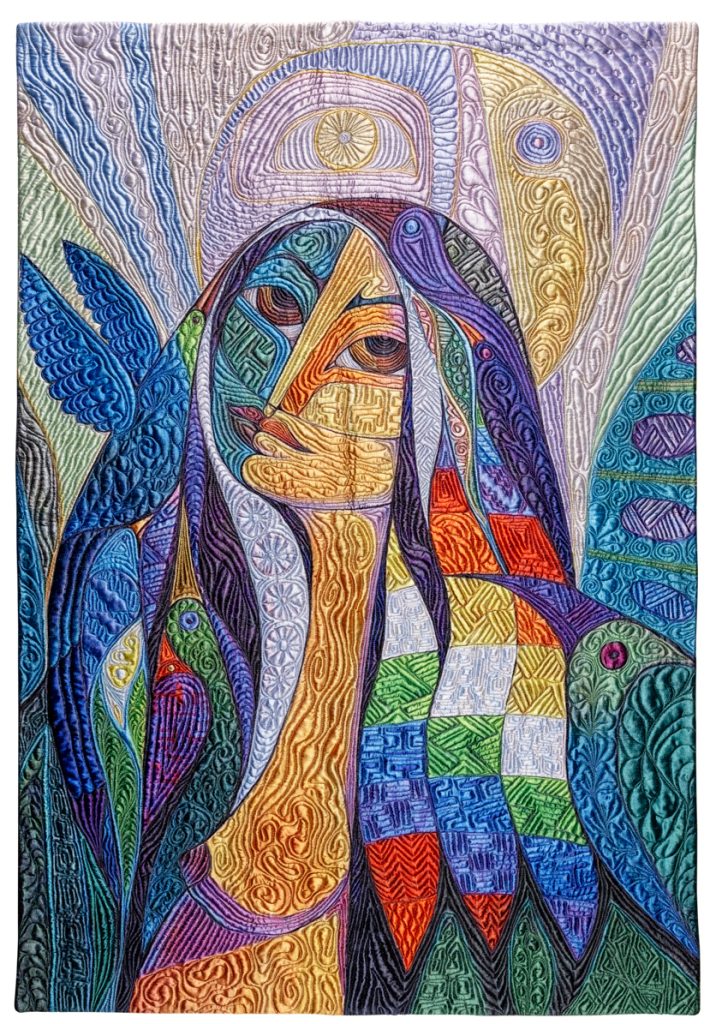
America Morena
by Estela Mota
São Bernardo do Campo, SP
Brazil
Techniques: Machine appliqué and quilting; professional fabric printing; digital printing on satin; wholecloth
Design Source: Miguel Haucen; with permission
America Morena is a creation by Miguel Haucen and authorized to be reproduced in an art quilt. As he said, this lady is a New Guarani woman, who represents all the other Brazilian Indians, portraying our rich Brazilian flora. This is a wholecloth of the work in natural size, with more than 200 colors of thread. It was an award-winning work at the Carrefour European in 2023. I wanted to compose in lines the same softness of her features.
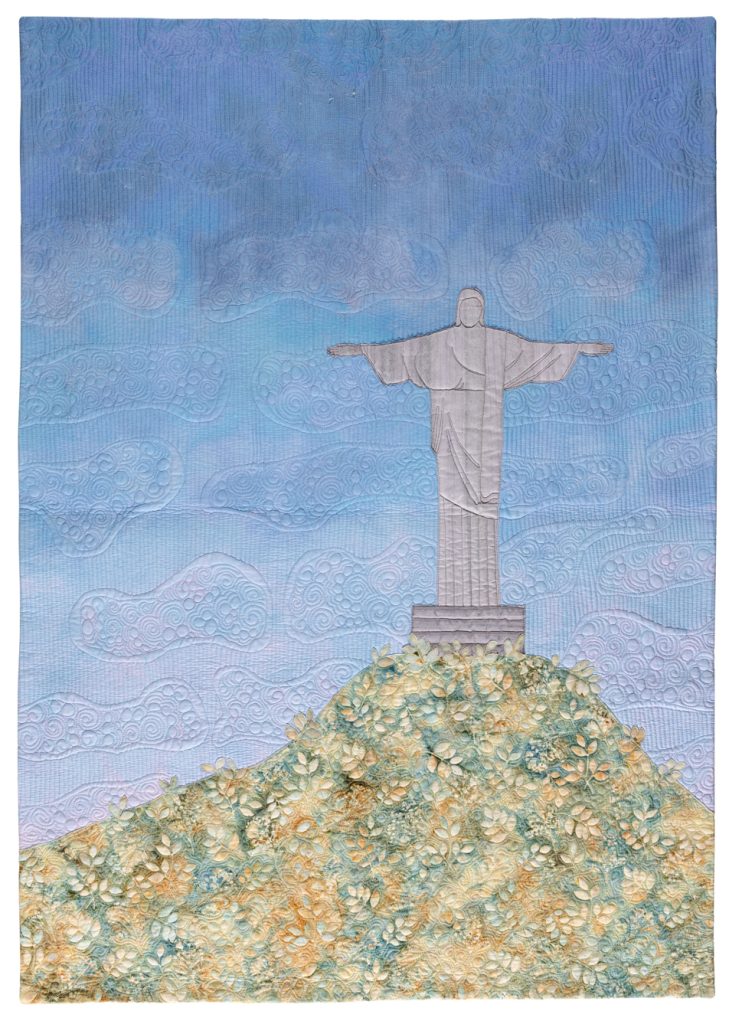
Aquele Abraço!
by Veronica Abad
São Bernardo do Campo, SP
Brazil
Techniques: Machine appliqué and quilting; fusing; collage
Design Source: Original design
There’s no translation for Aquele Abraçointo in other languages. But as a good Carioca would say, “This is the way Christ embraces all of us Brazilians.” On Corcovado, 709 meters above sea level, it overlooks Guanabara Bay, and its back is to the Tijuca Forest. It is made entirely of reinforced concrete and soapstone and is 30 m high, with arms stretching 28 m. It is a cultural icon of Rio de Janeiro and one of the Seven Wonders of the Modern World by UNESCO.

At a Gallop
by Adriana H.M.U. Sleutjes
São Bernardo do Campo, SP
Brazil
Techniques: Hand appliqué, embellishment, embroidery, and piecing; machine appliqué, embellishment, and quilting; professional fabric printing; wholecloth; digital printing
Design Source: Original design
Mato Grosso – The Pantaneiro horse breed has adapted to the conditions of the Pantanal. It’s a unique breed that has developed over centuries of adaptation to high temperatures, droughts, and floods. It originates from horses that came from exploration expeditions into the interior of Brazil, which were organized since the 16th century, bringing horses from the natives of the Iberian Peninsula, as well as the Crioulo. They are wonderful and strong.

Boi Bumba
by Dulce Magalhães
São Bernardo do Campo, SP
Brazil
Techniques: Hand embellishment and painting; machine appliqué, embellishment, embroidery, and quilting; fusing
Design Source: Original design; Dulce Magalhães
MARANHÃO - An important manifestation of popular culture, Boi Bumbá involves devotion to the June Saints—Saint John, Saint Peter, and Saint Marçal. The story comes from the colonial period, when on a farm, a slave kills the Lord’s favorite ox to satisfy his pregnant wife’s desire to eat the ox’s tongue. The master, furious, forces the slave to bring the ox back. Healers are called, and they save the ox. This is on the UNESCO Intangible Cultural Heritage of Humanity list.
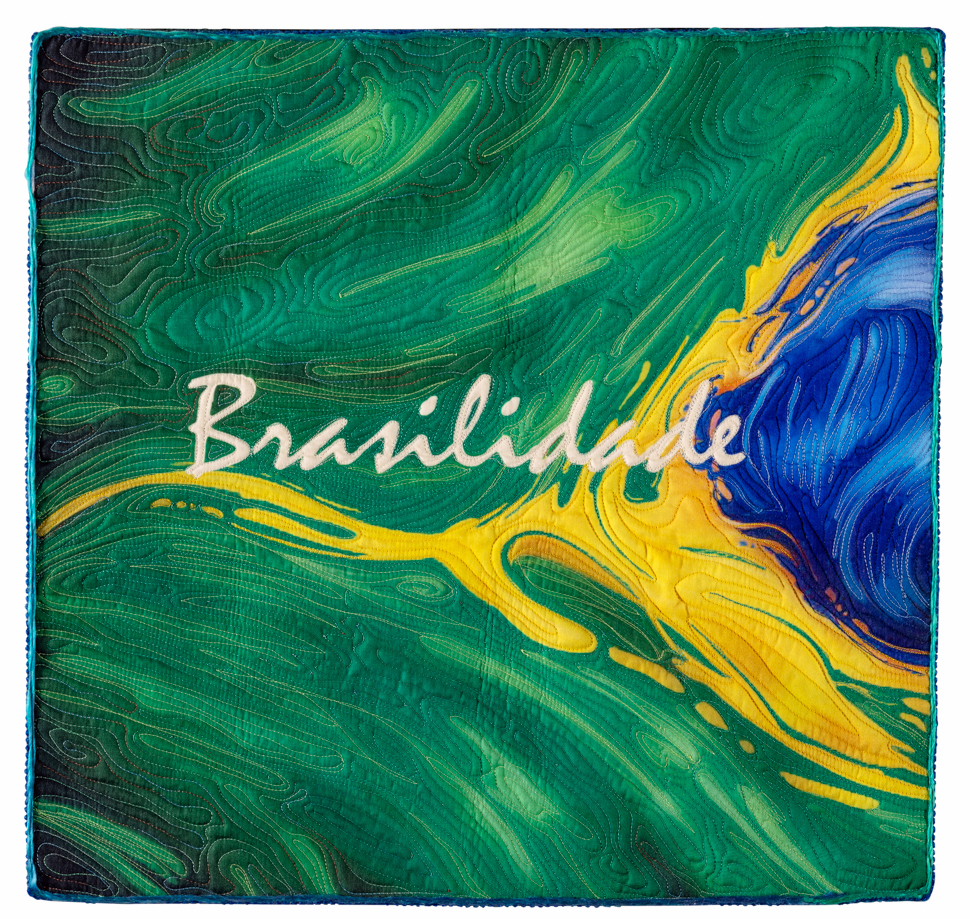
Brasilidade
by Estela Mota
São Bernardo do Campo, São Paulo,
Brazil
Techniques: Digital printing; machine quilting; wholecloth
Design Source: Original design
The concept of Brazilianess is based on aspects of national culture—those linked to nature and life in large centers—and its source of inspiration is working with shapes and textures, referring to our rich fauna and flora, the antithesis of our large metropolises.

Brazil’s Map
by Sandra Caruso
São Bernardo do Campo, SP
Brazil
Techniques: Professional fabric printing; wholecloth; digital printing; machine quilting
Design Source: Original design
This work seeks to portray a small portion of the natural beauty and diversity of the Brazilian people. From the indigenous people to Niemeyer (the Brazilian architect), the forests, mountains, and waterfalls, to the dunes and paradisiacal beaches…to guaraná, açaí, coffee, chimarrão, and wine…to the handicrafts made with golden grass from Japapão to the lace and basketwork of the Northeast. Frevo, Carnival, we’ve got everything to warm the hearts of the world!
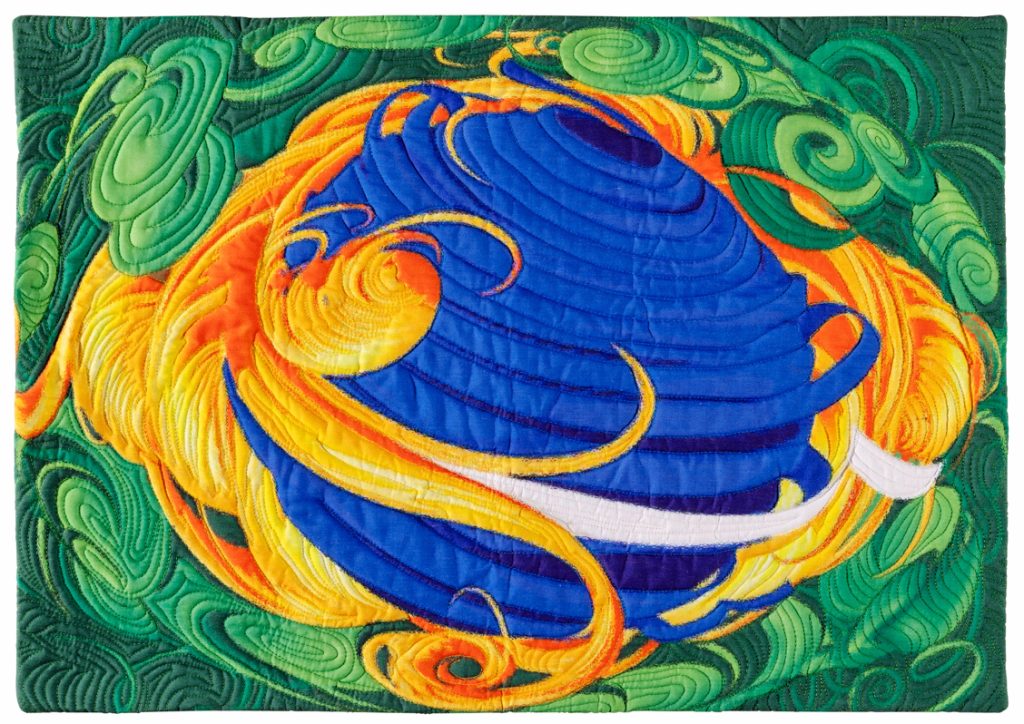
Brazilian Flag
by Veronica Abad
São Bernardo do Campo, SP
Brazil
Techniques: Professional fabric printing; digital printing; wholecloth; machine quilting
Design Source: Original design
The national flag was instituted in 1889, after the Proclamation of the Republic. The Green color represents the House of Braganza, the Portuguese royal family, and the yellow represents the Habsburgs, the family of Empress Leopoldina. In addition, the colors represent the country’s riches: green represents the forests and woodlands, yellow mineral wealth, blue is the sky, and white represents peace.

Breathing Soul
by Estela Mota
São Bernardo do Campo, SP
Brazil
Techniques:Fabric manipulation; mixed media; felting; hand painting; machine quilting
AMAZONAS - We don't have to be as thoughtful as Rodin. We have reached a point where all we can do is act. Always preserve and take actions that collectively become proactive. That is the reason that this work was done in layers. Alone, we can achieve nothing, but together we can breathe more easily again. Preserve our fauna and flora.
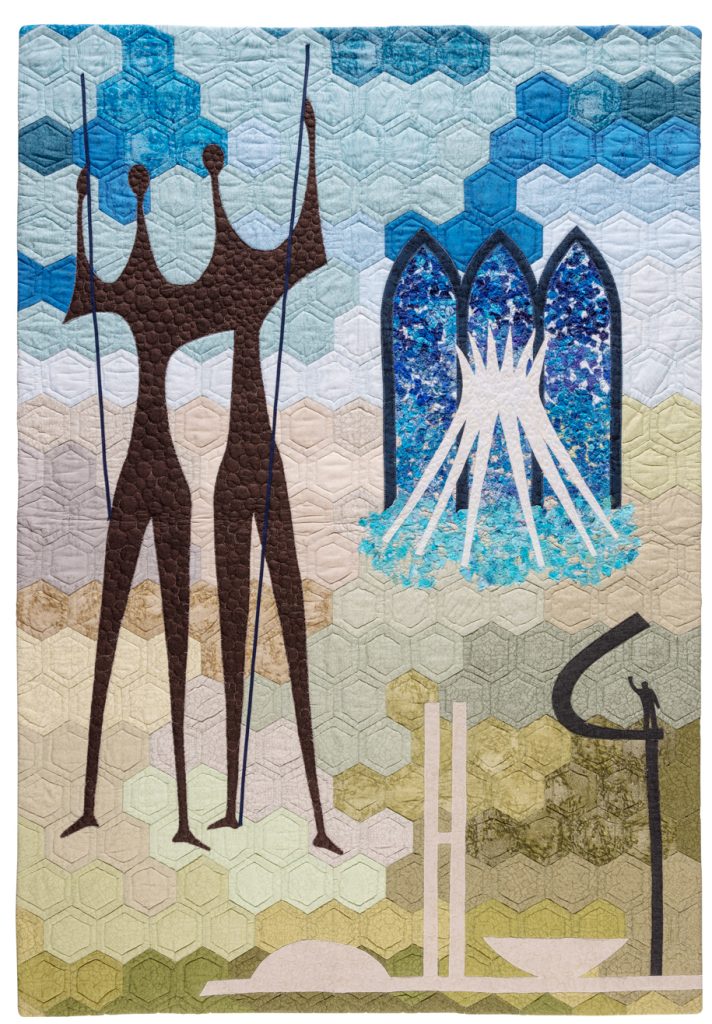
Candangos
by Rosa Maria Fiuza
São Bernardo do Campo, SP
Brazil
Techniques: Hand appliqué and piecing; machine appliqué and quilting; fusing; painting
Design Source: Original design
BRASILIA - Candangos is a term that refers to the pioneers who built Brasilia in 1960. In this work, we have the main monuments of this capital, so avant-garde in its architecture, designed mainly by Oscar Niemeyer. The Candangos are re-immortalized in this sculpture in the Praça dos Três Poderes, as well as the Metropolitan Cathedral and all its blue light, and the JK Memorial, in homage to President Juscelino Kubitschek, who idealized our capital.

Canyon in the Rio Grande do Sul
by Adriana H.M.U. Sleutjes
Porto Alegre, SP
Brazil
Techniques: Hand appliqué, embellishment, and embroidery; machine appliqué and quilting
Design Source: Original design
RIO GRANDE DO SUL - Formed by a long and winding escarpment (stone walls) that separates two compartments, the plateau and the coastal plain, it has slopes that reach 1,000 m, located less than 50 km from the sea. There are beautiful canyons full of waterfalls and natural pools. The coastal zone completes the diversity and exuberance, with impressive vegetation, stunning landscapes, and the biodiversity of the mountain slopes.

Coffe in Paulista
by Rute Sato
São Paulo, SP
Brazil
Techniques: Hand embellishment and painting; machine appliqué, piecing, and quilting; fusing
Design Source: Original design
SÃO PAULO - Paulista Avenue is a symbol of the city. It was opened on December 8, 1891. For a time, it housed mansions belonging to wealthy families from São Paulo, such as large landowners. Today, in addition to housing the business world, it houses numerous cultural centers and museums. MASP (São Paulo Museum of Art) draws attention for its modern architecture by Lina Bo Bardi. I like walking on this avenue and taking a break for a coffee.
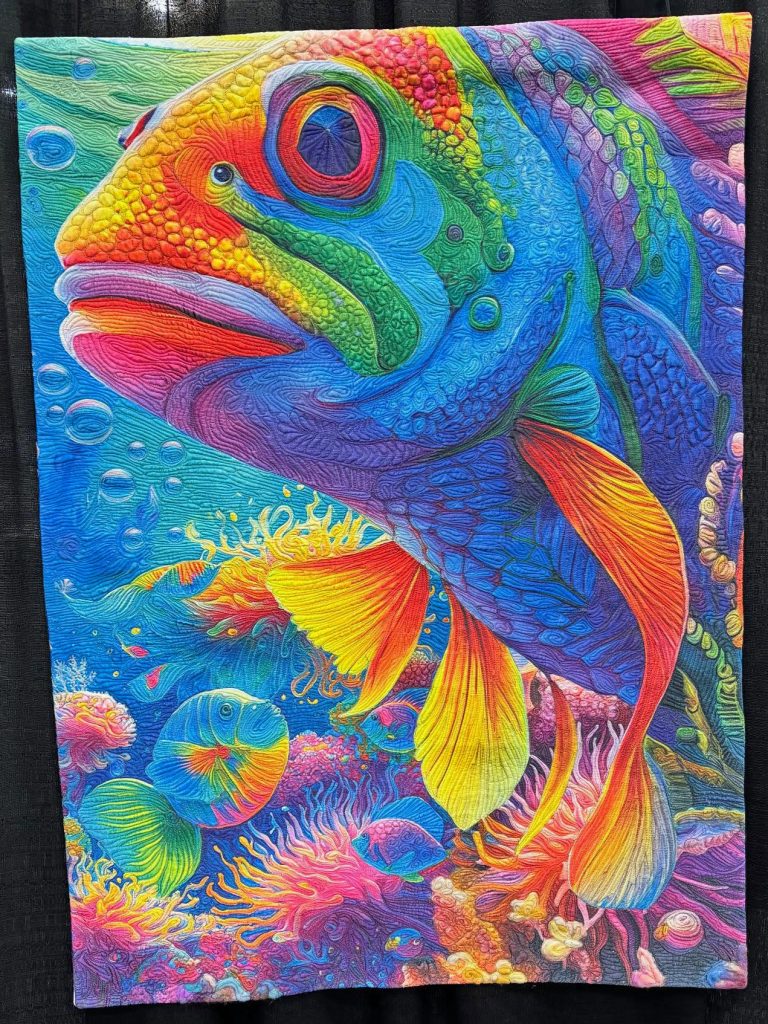
Forest Fish
by Estela Mota
São Bernarndo do Campo, São Paulo
Brazil
Techniques: Hand appliqué, embellishment, painting, piecing, and felting; machine appliqué, embellishment, felting, and quilting; professional fabric printing; mixed media; fabric manipulation
Design Source: Original design
So that we don’t lack colors, water and beaches in this life... Diving off the Brazilian coast, we have the chance to come across colorful and lively fish. Life is made of small flashes, and this is my precious fish, where each color stands out in a quilting movement. Felting and whole cloth in satin, with more than 200 thread colors, nothing better to represent this precious thing that seduces us just by looking at it!
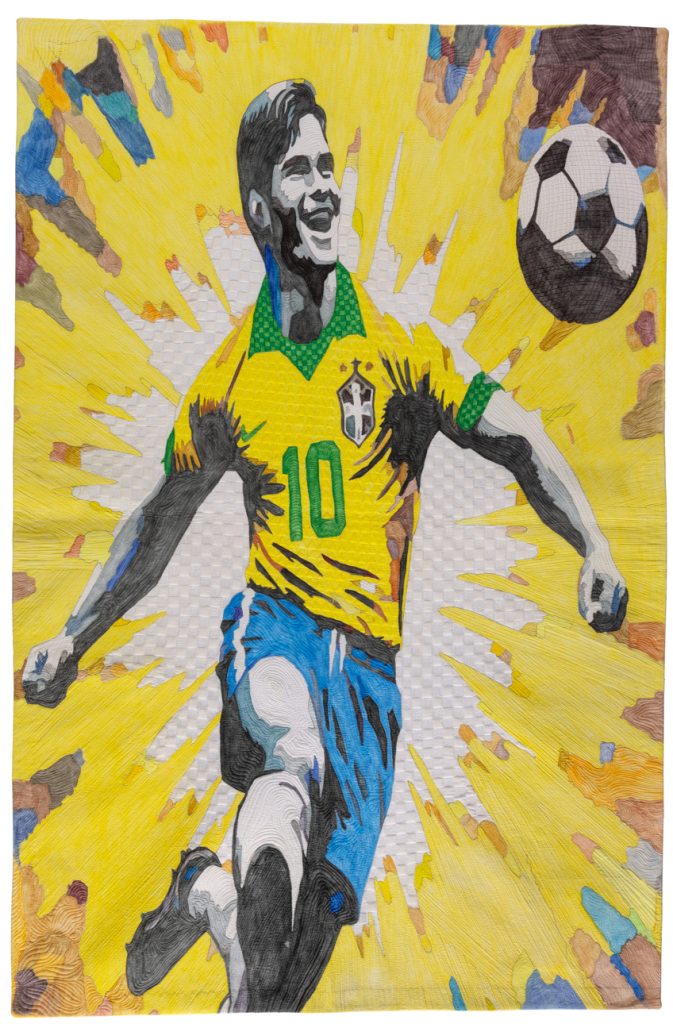
Goal at Maracanã
by Marcio Lima
São Bernardo do Campo, SP
Brazil
Techniques: Hand painting; machine quilting
Design Source: Original design
RIO DE JANEIRO - Opened on June 16, 1950, the Jornalista Mario Filho Stadium, Maracanã, is known worldwide as the temple of football. A second home for every Carioca (native of Rio de Janeiro), it has a history that transcends the borders of Rio de Janeiro and Brazil. Football is a national passion!
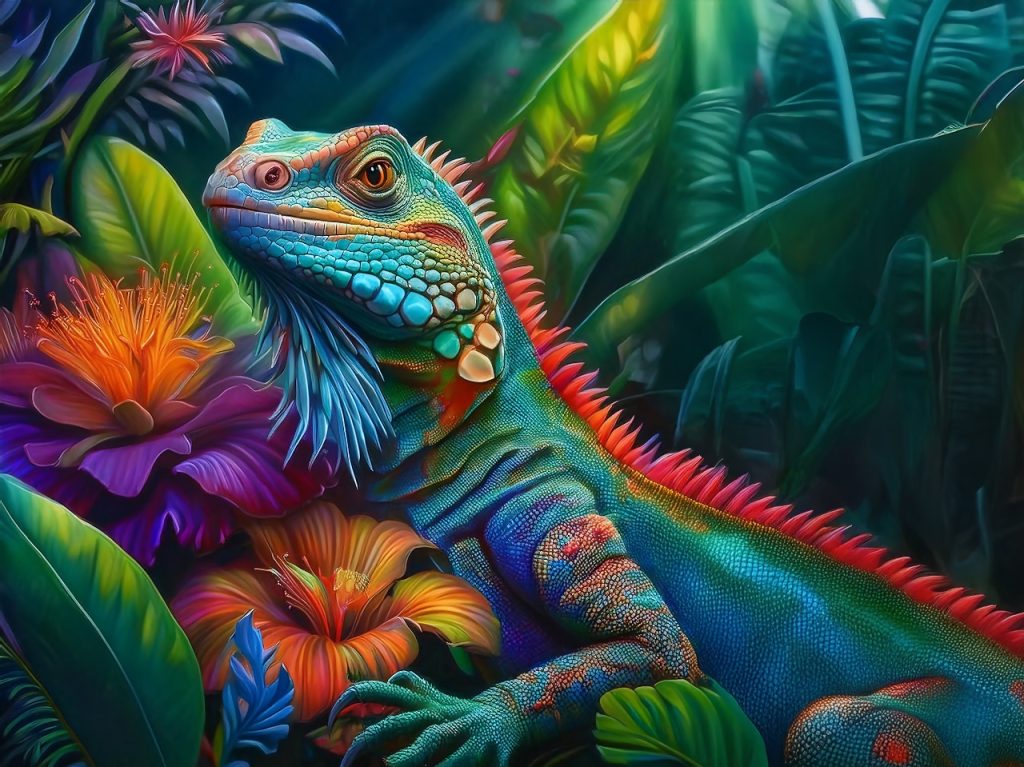
Iguana
by Estela Mota
São Bernardo do Campo, SP
Brazil
Techniques: Professional fabric printing; digital printing; AI; wholecloth; machine quilting
p;
Design Source: Original design
RONDONIA - These fascinating creatures spread seed and are true living camouflage, helping to preserve our ecosystem. In this rich Brazilian region, there are several types of iguanas, and they love to stabilize their body temperatures in the trees. Their colorful colors give a special charm to a region as blessed as the North of Brazil. I used almost 350 colors of thread in this work.

Indio Xocó
by Marcio Lima
Sao Bernardo do Campo, São Paulo
Brazil
Techniques: Hand painting; machine quilting
Design Source: Original design
SERGIPE - At the time of the discovery of Brazil, the lands of Sergipe were inhabited by several indigenous tribes. In addition to the Tupinambás and Caetés, there were around 30 villages in Sergipe belonging to the Tupi Group. Currently, the only existing tribe is the Xocó, which lives on the island of São Pedro, in the municipality of Porto da Folha.
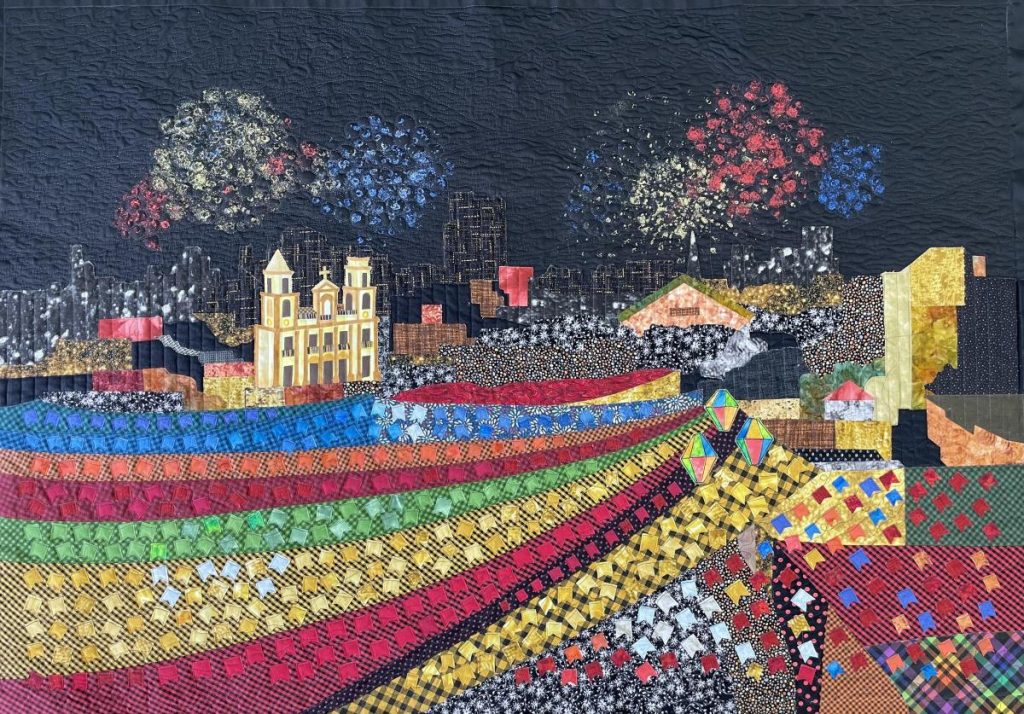
June Celebration
by Rute Sato
São Bernardo do Campo, SP
Brazil
Techniques: Hand embellishment and painting; machine appliqué, embroidery, and quilting; collage
Design Source: Original design
PARAIBA - The June Festival has Catholic origins and pays homage to St. Anthony, St. John, and St. Peter. It’s celebrated in all regions of Brazil, but the largest celebration takes place in the Northeast. The city of Campina Grande hosts the São João Festival. The event brings life to the city throughout the month of June, with performances by forró artists, square dance competitions, typical foods, and the little flags.
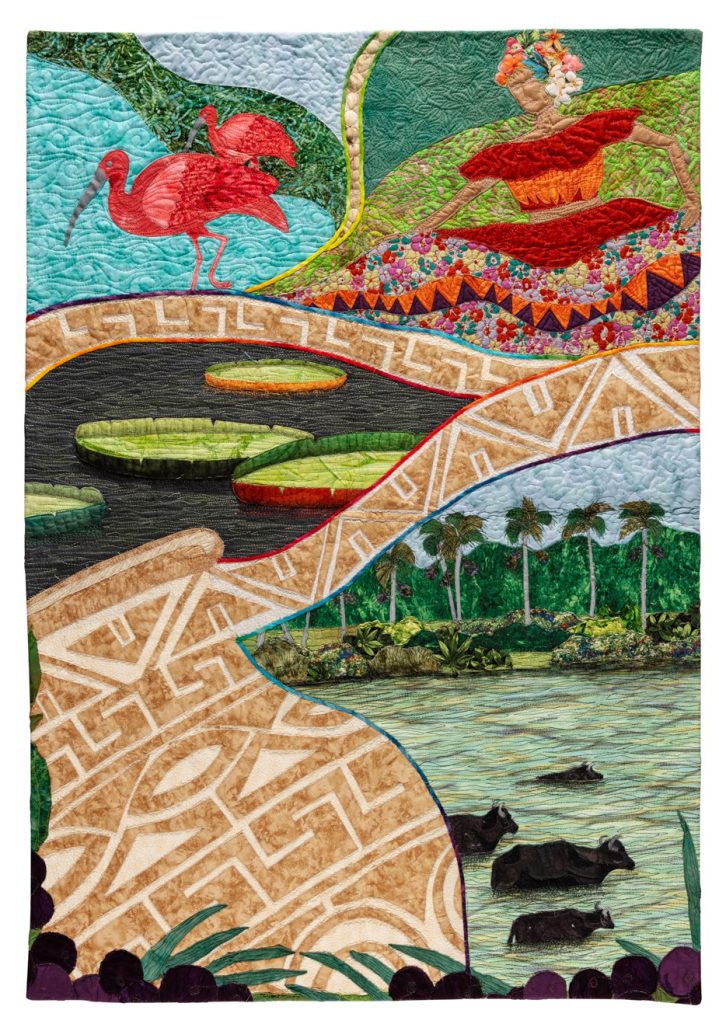
Marajó’s Island
by Myrian Melo
São Bernardo do Campo, SP
Brazil
Techniques: Hand appliqué and painting; machine appliqué, embroidery, piecing, and quilting; fusing; confetti
Design Source: Original design
PARÁ - On Marajó Island, buffalo roam in flooded fields and white Marajó pottery tells the secrets of the land. Dances echo among açaí palms, and the red heron dances in the sky. Marajó is where nature and art embrace, weaving stories under the tropical sun.
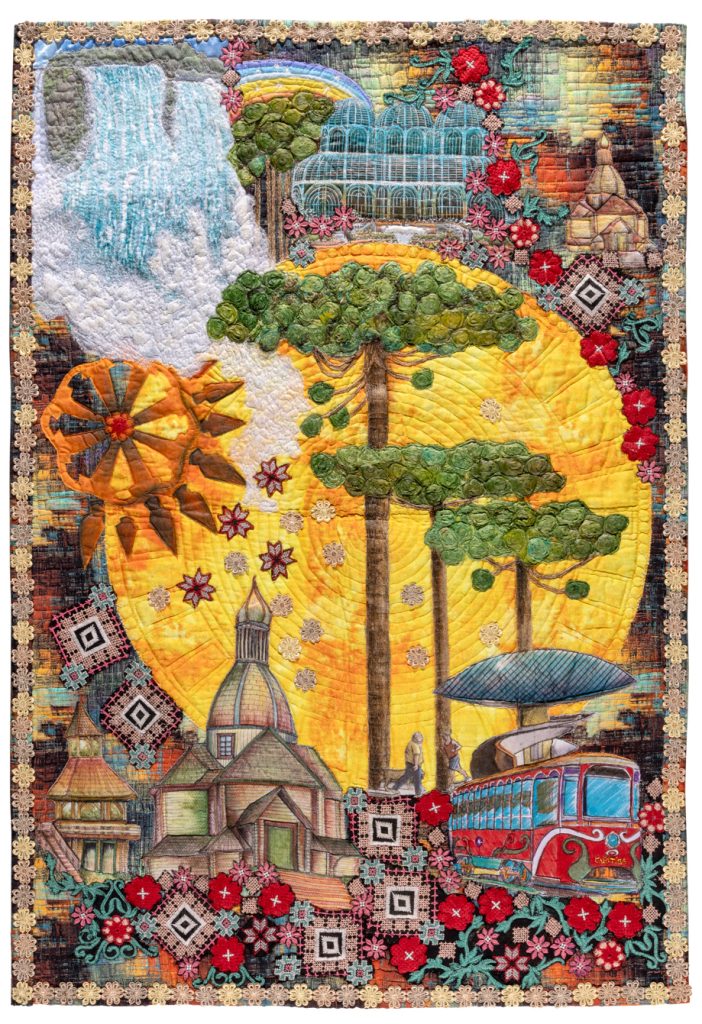
My Paraná
by Silvia Rohden
São Bernardo do Campo, SP
Brazil
Techniques: Hand embroidery and painting; machine appliqué, embellishment, embroidery, piecing, and quilting; collage
Design Source: Original design
PARANÁ – This is a beautiful state in southern Brazil, where the Iguaçu Falls are located. It was elected as one of the Seven Natural Wonders of the World. This region has hundreds of waterfalls and is home to a subtropical forest with several wild species. The symbolic tree is the Araucaria, which is cup-shaped and belongs to one of the largest species. Curitiba, the capital, is an ecological city, well-forested, with large parks and wonderful museums.
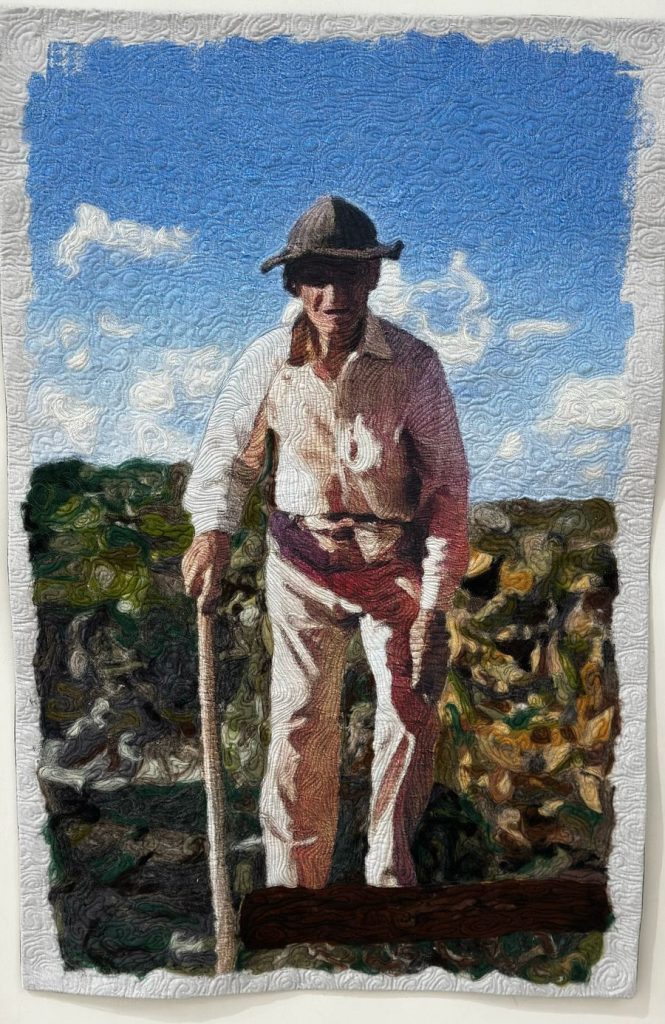
Old Chico
by Estela Mota
São Bernardo do Campo, SP
Brazil
Techniques: Professional fabric printing; mixed media; digital printing; felting; trapunto; machine quilting
Design Source: Original design; from a picture of my grandfather
BAHIA - The Brazilian Northeast is known as a region of strong warriors and very happy people. Despite all the aridity, its cuisine is very rich and tasty. The people are affectionate and very welcoming, and there is no shortage of hugs and sitting down to listen to a good story. This photo is from the last century, but Velho Chico lived for another 90 years, where he planted and grew his crops, his children, and especially, his spirituality.

Ouro Preto, Our History!
by Dulce Magalhães
São Bernardo do Campo, SP
Brazil
Techniques: Hand appliqué, embellishment, painting, and piecing; machine appliqué and quilting; fusing; confetti
Design Source: Original design
MINAS GERAIS - Ouro Preto was founded in the mid-18th century and was very important in the colonial period due to its wealth in dark gold, from which its name comes. It was the first Brazilian historical site to be considered a world heritage site by UNESCO. On its hillsides, you can learn about our history, as well as its natural and architectural beauties. Colonial mansions, churches full of gold, and lots of baroque art sometimes hide in the mist.
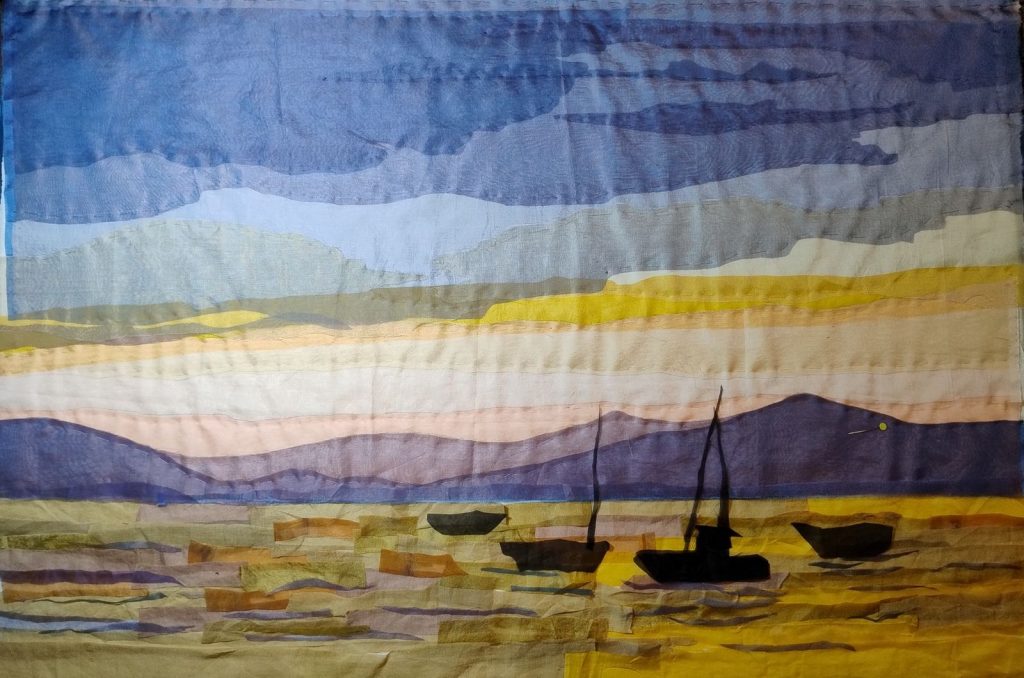
Paradise
by Carmem Netto
São Bernarndo do Campo, São Paulo
Brazil
Techniques: Hand appliqué, piecing, and quilting; machine appliqué, piecing, and quilting
Design Source: Original design
SANTA CATARINA - The sunsets at sea in this place, with the colors that change at every moment, and tones that intensify, dilute, and blend, remind us that we are already living in paradise.
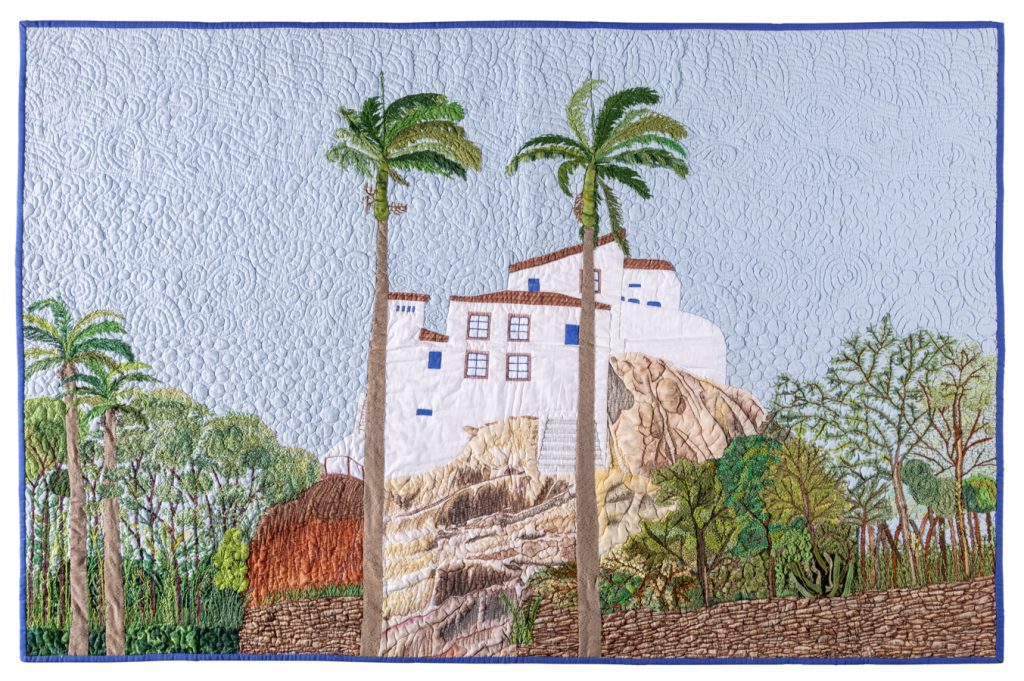
Penha, Light, and Faith
by Aparecida Barbosa
São Bernardo do Campo, SP
Brazil
Techniques: Hand appliqué, embellishment, and embroidery; machine appliqué and quilting
Design Source: Original design
ESPIRITO SANTO - Convento da Penha is a Marian Sanctuary located in Vila Velha and is considered one of the most important tourist attractions. Located on top of a cliff, its construction began in 1558, and it’s considered one of the oldest churches in Brazil. Its entire interior is covered with early wood and carved by the Portuguese sculptor José Fernandes Pereira. There are four paintings produced by Benedito Calixto inside.

Pirangi Cashew Tree
by Rosa Maria Fiuza
São Bernardo do Campo, SP
Brazil
Techniques: Hand appliqué, embellishment, and embroidery; machine appliqué, embroidery, and quilting; mixed media; felting
Design Source: Original design
RIO GRANDE DO NORTE - In 1888, Luiz I. Oliveira, a fisherman who lived on Pirangi Beach, planted a cashew tree to enjoy its fruits. In 1994, it was included in the Guinness Book of Records. This is due to an anomaly—the branches of this plant grow sideways and return to the ground, creating roots again and forming an immense canopy of 8,500 m, and it can produce 80,000 fruits.

Rooster Carnival
by Estela Mota
São Bernardo do Campo, SP
Brazil
Techniques: Professional fabric printing; wholecloth in satin; machine quilting
Design Source: Original design
PERNAMBUCO - Galo da Madrugada is a carnival block from Recife, which parades on Carnival Saturday. It’s considered the largest carnival block in the world. I worked with strong colors, like in the Frevo, the music of this party. It runs 6.5 km, carrying more than 2.5 million happy revelers, dancing all the time. It has 46 years of history and 44 parades. I used 350 types of thread colors, like the true colors at our party.

Skyline
by Marina Landi
São Bernardo do Campo, SP
Brazil
Techniques: Machine appliqué and quilting; fabric manipulation
Design Source: Original design
SÃO PAULO - This is the most populous city in Brazil. An alpha global city, it exerts significant international influence in commerce, finance, arts, and entertainment. It is the most populous urban area in the world outside of Asia. It is marked by rich architecture and has several of the tallest skyscrapers in Brazil. The overlapping fabrics indirectly refer to the overlapping of people, where the city has no more room to grow.
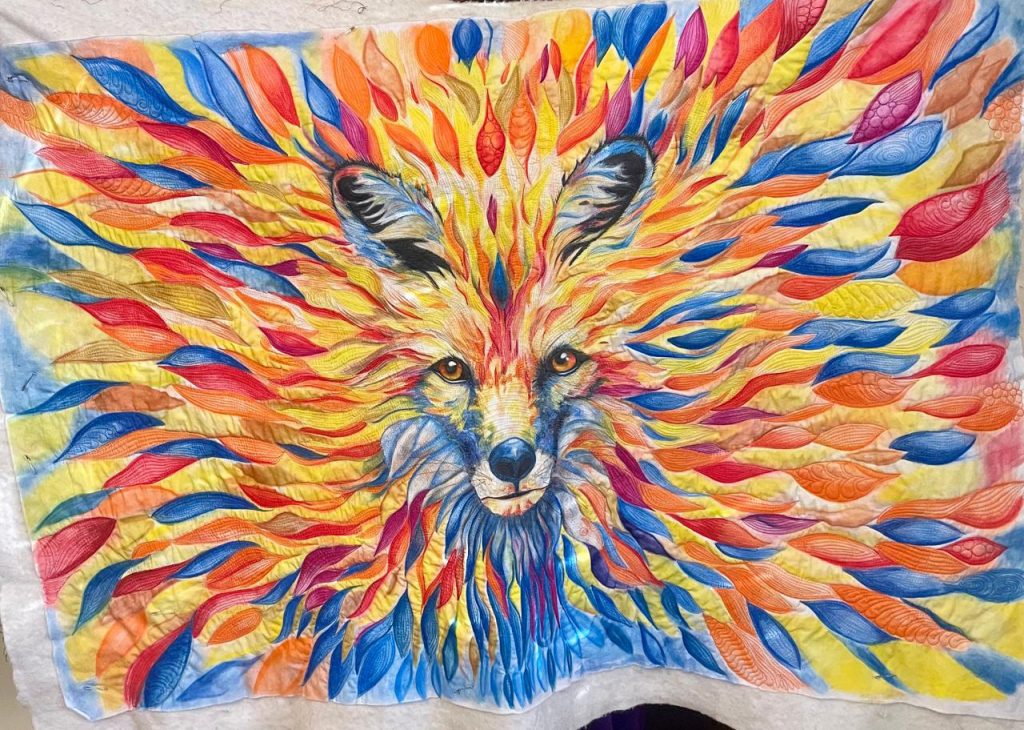
The Maned Wolf
by Mariliz Bocate
São Bernardo do Campo, SP
Brazil
Techniques: Hand painting; machine quilting
Design Source: Original design
GOIAS - The Maned Wolf is one of the symbols of the Cerrado. Considered the largest South American canid, this animal is solitary, usually harmless, and quite shy, avoiding contact with humans. It’s found in open areas, such as fields, where it is usually seen at the end of the day and at night. The species is suffering from the destruction of its habitat, and Brazil is home to almost 90% of the population. Guará means red, our Lobo Guará!
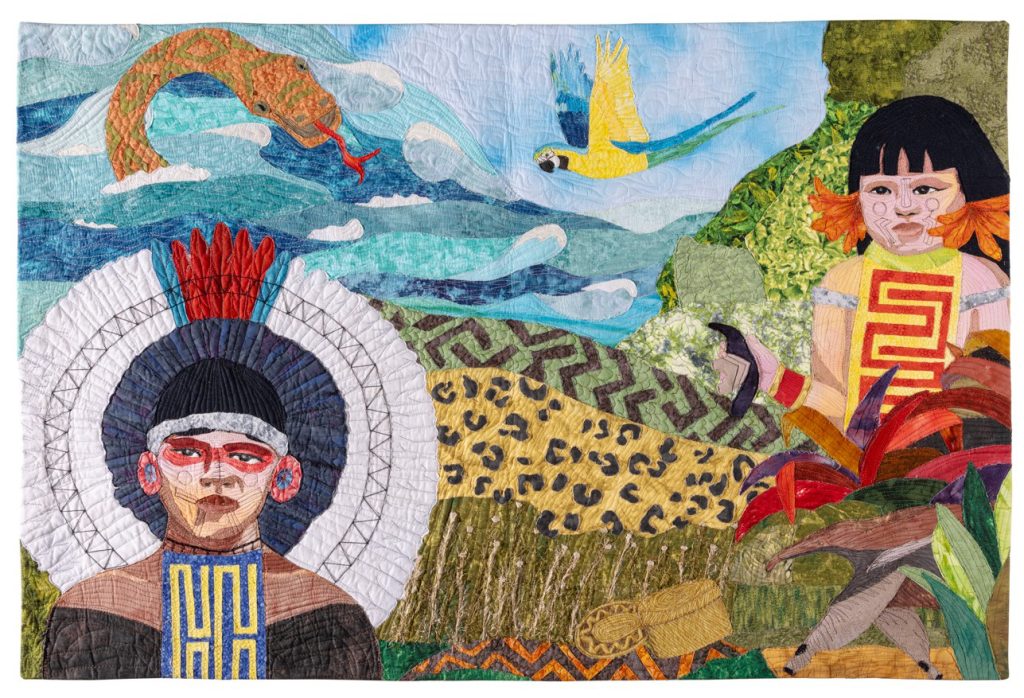
Tocantis
by Myrian Melo
São Bernarndo do Campo, São Paulo
Brazil
Techniques: Hand painting; machine appliqué, embellishment, embroidery, piecing, and quilting; mixed media; collage
Design Source: Original design
TOCANTIS – This is a vibrant state in the heart of Brazil. A true mosaic of cultures and natural beauty, with its vast landscapes ranging from savannah to lush rivers, the state is also home to several indigenous people, who bring with them a rich cultural heritage and a deep connection to the land. The strength of these people is reflected in the fight to preserve their lands and cultures, showing the world respect for roots and diversity.

Wild Beauty
by Monika Wutzl
São Bernardo do Campo, SP
Brazil
Techniques: Machine appliqué, embellishment, embroidery, and quilting; fusing; confetti; painting; pre-turned edge and raw-edge appliqué
Design Source: Stephanie Simioni - the photograph used to create the jaguar image was taken by her and used with her permission
MATO GROSSO DO SUL - The Pantanal contains the richness of the region’s fauna and flora. It is unique and unlike any other place in the world. It is home to more than 3,500 species of plants, 650 species of birds, 12 species of mammals, 80 reptiles, 60 amphibians, and 260 freshwater fish. The Jaguar is one of the symbols, and around it, you can see the yacaré caiman, anaconda, giant anteater, hyacinth macaw, capybara, marsh deer, and Jabiru.

Yanomani Territory
by Carmem Netto
Gramado, SP
Brazil
Techniques: Hand appliqué, embellishment, embroidery, and quilting; machine appliqué, embroidery, and quilting; improvised background
Design Source: Original design
RORAIMA - The scientific community considers this a priority region in terms of biodiversity protection in the Brazilian Amazon. Portraying the colors of the forest would be the most obvious. The challenge was to portray the clarity and wisdom of these people, from whom we have much to learn and respect. This is a tribute to the native peoples of the country.


